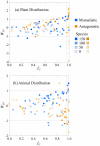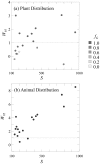Biology, methodology or chance? The degree distributions of bipartite ecological networks
- PMID: 21390231
- PMCID: PMC3048397
- DOI: 10.1371/journal.pone.0017645
Biology, methodology or chance? The degree distributions of bipartite ecological networks
Abstract
The distribution of the number of links per species, or degree distribution, is widely used as a summary of the topology of complex networks. Degree distributions have been studied in a range of ecological networks, including both mutualistic bipartite networks of plants and pollinators or seed dispersers and antagonistic bipartite networks of plants and their consumers. The shape of a degree distribution, for example whether it follows an exponential or power-law form, is typically taken to be indicative of the processes structuring the network. The skewed degree distributions of bipartite mutualistic and antagonistic networks are usually assumed to show that ecological or co-evolutionary processes constrain the relative numbers of specialists and generalists in the network. I show that a simple null model based on the principle of maximum entropy cannot be rejected as a model for the degree distributions in most of the 115 bipartite ecological networks tested here. The model requires knowledge of the number of nodes and links in the network, but needs no other ecological information. The model cannot be rejected for 159 (69%) of the 230 degree distributions of the 115 networks tested. It performed equally well on the plant and animal degree distributions, and cannot be rejected for 81 (70%) of the 115 plant distributions and 78 (68%) of the animal distributions. There are consistent differences between the degree distributions of mutualistic and antagonistic networks, suggesting that different processes are constraining these two classes of networks. Fit to the MaxEnt null model is consistently poor among the largest mutualistic networks. Potential ecological and methodological explanations for deviations from the model suggest that spatial and temporal heterogeneity are important drivers of the structure of these large networks.
Conflict of interest statement
Figures




References
-
- May RM. Network structure and the biology of populations. Trends in Ecology & Evolution. 2006;21:394–399. - PubMed
-
- Montoya JM, Pimm SL, Sole RV. Ecological networks and their fragility. Nature. 2006;442:259–264. - PubMed
-
- Cohen JE. Food Webs and Niche Space. Princeton, N.J.: Princeton University Press; 1978.
-
- Dunne JA. The network structure of food webs. In: Pascual M, Dunne JA, editors. Ecological Networks: Linking Structure to Dynamics in Food Webs. New York: Oxford University Press; 2006.
-
- Elton CS. Animal Ecology. London: Sidgwick and Jackson; 1927.
MeSH terms
LinkOut - more resources
Full Text Sources

